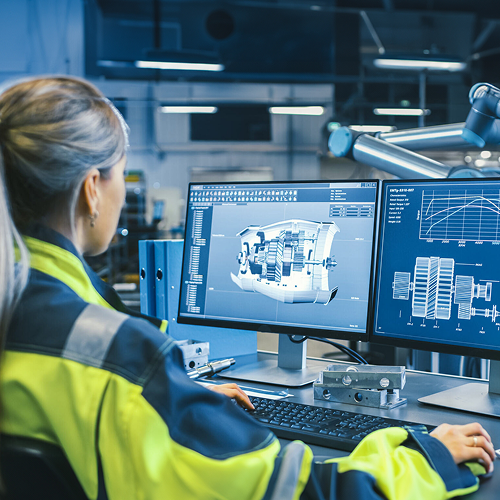


Computational Fluid Dynamics (CFD) is a powerful simulation tool used to model the behaviour of fluids—such as air and smoke—within a building or industrial environment. At AESG, our CFD analysis plays a crucial role in enhancing fire safety, optimising HVAC system performance, and improving overall building design. By simulating the movement and interaction of gases and particulates, we provide insights that inform design decisions, compliance, and risk mitigation.
CFD uses mathematical modelling and numerical methods to predict fluid flow behaviour in complex environments. By applying CFD simulations, AESG can analyse scenarios that are difficult or impossible to test physically, providing a detailed understanding of how air, heat, and smoke will behave during different conditions. This capability is essential for:

Simulating the spread of smoke, heat, and toxic gases during a fire, allowing for the optimisation of smoke control systems and safe evacuation strategies.

Evaluating airflow distribution to ensure effective ventilation in enclosed spaces, such as tunnels, large atriums, or underground car parks.

Optimising heating, ventilation, and air conditioning (HVAC) systems for occupant comfort and energy efficiency.

Assessing the impact of potential blast scenarios on structural integrity and occupant safety.
Our CFD services cover a wide range of applications, including:
Using CFD to simulate the spread of fire and smoke under different scenarios, providing critical data for designing smoke control and evacuation strategies.
Evaluating airflow and temperature distribution to enhance thermal comfort and ensure efficient HVAC system operation.
Modelling the rate at which heat is released during a fire, helping to determine the severity of fire scenarios and the required performance of fire protection systems.
Conducting CFD simulations to predict the impact of potential explosions in industrial environments, aiding in the design of blast-resistant structures.
Analysing wind behaviour around tall buildings or in urban environments to assess potential effects on pedestrian comfort and safety.
Assessing temperature and air movement patterns within spaces to optimise occupant comfort and energy efficiency.
Our CFD expertise supports a variety of sectors, including:
Optimising smoke control, ventilation, and occupant safety.
Ensuring effective ventilation and air quality for sensitive environments.
Assessing explosion risks and ensuring safe airflow in hazardous environments.
Analysing fluid flow in tunnels, stations, and aircraft hangars.
Our commitment to fire and life safety is demonstrated through a portfolio of successful projects, including:
Leverage AESG's advanced CFD services to optimise your building's fire safety, ventilation, and overall design. Contact us today to discuss your project needs or request a customised CFD analysis.
Cayan Business Tower
3rd, 6th & 11th Floor
Barsha Heights
P.O. Box 2556
Dubai, United Arab Emirates
T / +971 (0) 4 432 6242
305 Mermaid House
2 Puddle Dock
London, EC4V 3DS
United Kingdom
T / +44 (0) 208 037 8762
Office 37, Haibu Space
1st floor, Abu Dhabi Mall
Tourist Club Area
Abu Dhabi, United Arab Emirates
T / +971 (0) 2 201 2500
9391 Wadi Al Thummamah
2444 Al Olaya District
PO Box 12214
Riyadh, Kingdom of Saudi Arabia
T / +966 (0) 112 278 288
111 Somerset Road
#08-10A, 111 Somerset
Singapore 238164
WeWork, 80 Strand St
Cape Town City Centre
Cape Town, 8001
South Africa
T / +27 21 137 6444
49th Floor, Office No.117
8 Parramatta Square
Parramatta, Sydney
New South Wales 2150
Australia
T / +61 (0) 2 8042 6817
Regus Rialto, West Podium
Level Mezzanine 2 (M2)
525 Collins Street
Melbourne, Victoria 3000
Australia
Enawalks, 4th Floor, Office 417
Leaders International College Road
2F97+6VJ New Cairo 1
Cairo Governorate 4724242
Egypt
T / +20 15 01692187
Cayan Business Tower
3rd, 6th & 11th Floor
Barsha Heights
P.O. Box 2556
Dubai, United Arab Emirates
T / +971 (0) 4 432 6242
305 Mermaid House
2 Puddle Dock
London, EC4V 3DS
United Kingdom
T / +44 (0) 208 037 8762
Office 37, Haibu Space
1st floor, Abu Dhabi Mall
Tourist Club Area
Abu Dhabi, United Arab Emirates
T / +971 (0) 2 201 2500
9391 Wadi Al Thummamah
2444 Al Olaya District
PO Box 12214
Riyadh, Kingdom of Saudi Arabia
T / +966 (0) 112 278 288
111 Somerset Road
#08-10A, 111 Somerset
Singapore 238164
WeWork, 80 Strand St
Cape Town City Centre
Cape Town, 8001
South Africa
T / +27 21 137 6444
49th Floor, Office No.117
8 Parramatta Square
Parramatta, Sydney
New South Wales 2150
Australia
T / +61 (0) 2 8042 6817
Regus Rialto, West Podium
Level Mezzanine 2 (M2)
525 Collins Street
Melbourne, Victoria 3000
Australia
Enawalks, 4th Floor, Office 417
Leaders International College Road
2F97+6VJ New Cairo 1
Cairo Governorate 4724242
Egypt
T / +20 15 01692187